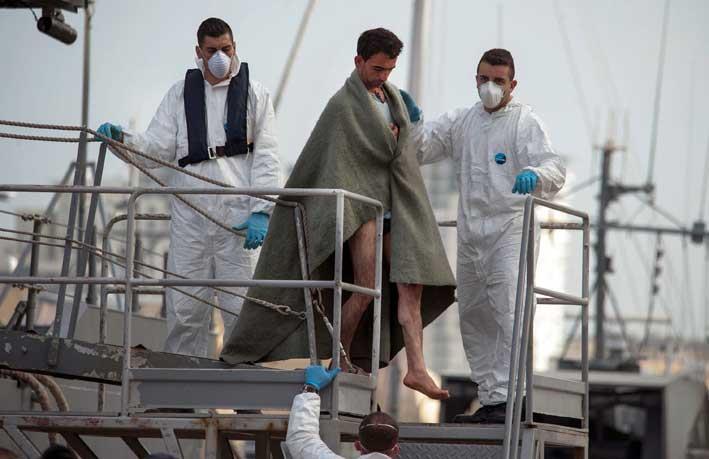An investigation into a report by one of the few survivors of the 11 October Lampedusa tragedy, calling on a prosecutor to establish who was responsible for the botched-up rescue operation, is still ongoing, more than 18 months later, an Italian lawyer has confirmed.
The Malta Independent on Sunday spoke to Alessandra Ballerini, a well-known lawyer specialising in human rights and immigration, who had filed the report on behalf of Syrian doctor Mohammad Jammo.

It was Dr Jammo, who saw two of his sons drown in the tragedy, who called the Italian and Maltese authorities from the sinking boat, using a satellite phone. He later recounted to Italian journalist Fabrizio Gatti how the Italians first said they would help and then told him to call Malta, and how the Maltese authorities had promised to help but dispatched their planes and ships after several hours had passed. The Maltese and Italian vessels reached the scene a full hour after the boat, carrying hundreds of Syrian refugees, capsized and sank, with the loss of more than 270 men, women and children.

The Malta Independent had reported how Italy and Malta had bickered over the rescue, wasting precious time that the migrants onboard the sinking boat did not have. Furthermore, Italian ships patrolling in the vicinity had stayed where they were, merchant vessels were not ordered to assist and Malta sent a patrol boat from base, which reached the site some time after the boat had capsized and sunk.
In the document delivered to a Palermo prosecutor, Dr Jammo writes how the boat on which he and the rest of his family had embarked on 10 October was holed below the waterline when armed Libyan men on a speedboat opened fire with their Kalashnikovs. Being one of the few who spoke good English, Dr Jammo was handed a satellite phone which he used to call the Italian authorities.
"I spoke to a woman and told her that our boat was sinking and we needed urgent assistance. I told her there were at least 250 adults and 150 children. I gave her our exact position using the GPS set. The equipment showed us that, at that time we were some 100 km away from Lampedusa and more than 200 km away from Malta. That is why we called Italy," he said.

Dr Jammo says help did not arrive. He called again and was passed over to someone else, a man, who then told him that he had to call the Maltese authorities. "I burst into tears and repeated that we were all going to die but the man just gave me the number for Malta and hung up."
Dr Jammo called Malta at 1pm and again at 3pm, when he was told help would arrive in 45 minutes. By 4pm, however, the promised help had still not arrived. He phoned again and was told that they had to wait another hour. At 5.07pm the boat capsized and sank. Many, including Dr Jammo's two sons, drowned. Their bodies would never be found.
Days after the tragedy, Dr Jammo was interviewed by L'Espresso journalist Fabrizio Gatti. The interview revealed that Italy and Malta had "passed the buck of responsibility" for the rescue and none of the several rescue units that had been in the vicinity of the migrant boat had been dispatched to assist before the vessel capsized and sank, taking with it more than 270 men, women and children to the bottom of the sea. One Italian warship, the ITS Libra, was only 27 miles away from the sinking boat and could have reached the scene by 3pm. For some reason, it was instructed to go around in circles at a speed of five knots and was only told to go to the rescue after the boat had turned turtle.
Passengers locked below decks, out of sight
The exact number has never been established but it is thought that up to 274 people died in the tragedy. Most of the 480 passengers were Syrians, but around 100 Sub-Saharan Africans had been locked away in the hold, unseen.
According to the accounts of the survivors, the African migrants were kept hidden to convince the Syrians that this particular boat would embark fewer passengers than usual – that is why they (the Syrians) were asked to pay a higher price - $3,000 each instead of $1,600.
It is also believed, since the boat was holed below the waterline by Libyan machine-gun fire, and the lower compartments were flooded, that those below drowned before the boat actually sank.
In his statement, Dr Jammo is asking the Palermo prosecutor to establish who was responsible for the questionable rescue operation and why the ITS Libra was not sent to the rescue on time.
At the time, Dr Ballerini had written that the answer to the question of who was responsible was a simple one: "The responsibility befell all those who could have attempted a rescue. When human lives are in danger, we cannot have a debate on who is more competent. It is a juridical duty, apart from a moral one, to act without procrastination. The Maritime Code provides for criminal penalties when one does not fulfil one's obligations at sea."
Speaking to this paper this week, the Italian lawyer said that the inquiry is ongoing and that she has recently received telephone calls from the Judicial Police.
She added that, unfortunately, this kind of investigation takes a rather long time to be completed. "In my country, the proper facts of tragedies are sometimes only established 20 years later. It is not a simple matter here."